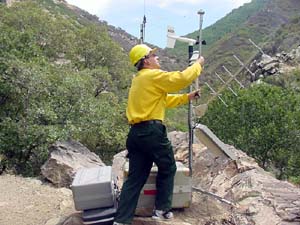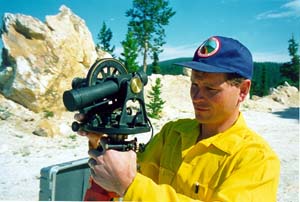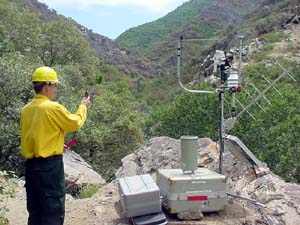| NOAA Magazine || NOAA Home Page |
HIGH-TECH METEOROLOGY HELPS NOAA FORECAST FIRE WEATHER
 July
23, 2003 � On-site weather support from NOAA National Weather Service
personnel for hazardous situations, such as wildfires
and chemical releases, is critical during such events. Incident Command
System weather support, in the form of forecasts and observations, is
accomplished by the use of portable special meteorological equipment.
This equipment includes the All-hazards Meteorological Response System,
the Atmospheric Theodolite Meteorological Unit, and Fire Remote Automated
Weather Stations. (Click NOAA image for larger view of IMET
Chuck Redman from the NOAA National Weather Service forecast office
in Boise, Idaho, setting up the FireRAWS equipment near a wildfire.
Click here for high resolution
version, which is a large file. Please credit “NOAA.”)
July
23, 2003 � On-site weather support from NOAA National Weather Service
personnel for hazardous situations, such as wildfires
and chemical releases, is critical during such events. Incident Command
System weather support, in the form of forecasts and observations, is
accomplished by the use of portable special meteorological equipment.
This equipment includes the All-hazards Meteorological Response System,
the Atmospheric Theodolite Meteorological Unit, and Fire Remote Automated
Weather Stations. (Click NOAA image for larger view of IMET
Chuck Redman from the NOAA National Weather Service forecast office
in Boise, Idaho, setting up the FireRAWS equipment near a wildfire.
Click here for high resolution
version, which is a large file. Please credit “NOAA.”)
The incident support group of the NOAA National Weather Service is primarily comprised of Incident Meteorologists, or IMETS, who are specially trained to install, operate and maintain the equipment while on-site at remote locations.
All-hazards
Meteorological Response Systems
The All-hazards Meteorological Response Systems (AMRS) has been implemented
nationally for the summer 2003 wildfire season. The equipment combines
advanced computer software and two-way satellite communications.
AMRS provide NOAA meteorologists high-speed access to state-of-the-art
weather data when at a remote location without relying on the use of
phone lines. The fast download speeds are advantageous for IMETs, since
they require large, highly perishable meteorological data sets to perform
their jobs. The laptop computers used by the IMETs have the FX-NET software,
and they can overlay satellite images and numerical forecast computer
models.
NOAA IMETs have completed certified installer training, required by the Federal Communications Commission, for installation of the two-way satellite equipment.
The advanced computer software available with AMRS was developed through a collaborative effort between staff in the NOAA National Weather Service Western Region headquarters in Salt Lake City, Utah, and the NOAA Forecast Systems Laboratories in Boulder, Colo.
FX-NET
The jewel of the IMET’s fire weather computer toolbox is the addition
of interactive weather data request and display software, known as FX-NET.
The software provides the deployed meteorologists with the ability to
use advanced weather processing software to display graphical images
and prepare their forecasts, just as if they were performing their duties
in one of the nation’s 122 NOAA National Weather Service forecast
offices.
IMETs can now access mesoscale numerical models, NOAA satellite imagery, specific wind speed and direction at various heights from the nearby Doppler weather radars or remote sensors by using one software program. In the past, IMETs accessed numerous programs for each needed weather data set. The speed and capability of AMRS allow for better on-site meteorological support, and in the end, increased safety of the personnel handling the hazardous incident.
The AMRS system was first tested by forecasters during the 2002 Olympic Winter Games in Salt Lake City, as well as by IMETs during the 2001 and 2002 wildfire seasons. During these prototype deployments, meteorologists were able to give the system rigorous field testing.
 Atmospheric
Theodolite Meteorological Unit
Atmospheric
Theodolite Meteorological Unit
Atmospheric Theodolite Meteorological Unit or ATMUs have been an essential
IMET tool for many years. The ATMU equipment has changed many times
over the years, but remains a valuable tool available in the IMET’s
toolbox. (Click NOAA image for larger view of NOAA forecaster
Troy Lindquist of the NOAA National Weather Service forecast office
in Grand Junction, Colo., using a theodolite to align the angle a weather
balloon takes after being launched. Please credit “NOAA.”)
The ATMU is composed of a theodolite (an instrument that is used in surveying and is used to find vertical and horizontal angles), tripod, weather balloons and miscellaneous tools for observing wind speed and direction at various heights above the incident location.
Wind forecasts and observation continue to be a very important weather element for wildfire and hazardous materials support, and the ATMU allows the IMET the ability to observe wind aloft by tracking the flight of a weather balloon.
Fire
Remote Automated Weather Stations
Fire Remote Automated Weather Stations (FireRAWS) are portable weather
stations available to the IMET and incident through the  management
of the Bureau of Land Management. These stations are intended for use
on or near the fire line or hazardous materials (hazmat) release, and
are easily relocated to points desired by the IMET. The stations continually
measure temperature, relative humidity, wind speed and direction, and
fuel moisture content. FireRAWS will also alert the forecaster (through
two-way radio) of rapidly changing weather conditions, such as strong
wind gusts. There are approximately 40 FireRAWS ready for deployment
across the country. (Click NOAA image for larger view of IMET
Chuck Redman from the NOAA National Weather Service forecast office
in Boise, Idaho, setting up the FireRAWS equipment near a wildfire.
Click here
for high resolution version, which is a large file. Please credit “NOAA.”)
management
of the Bureau of Land Management. These stations are intended for use
on or near the fire line or hazardous materials (hazmat) release, and
are easily relocated to points desired by the IMET. The stations continually
measure temperature, relative humidity, wind speed and direction, and
fuel moisture content. FireRAWS will also alert the forecaster (through
two-way radio) of rapidly changing weather conditions, such as strong
wind gusts. There are approximately 40 FireRAWS ready for deployment
across the country. (Click NOAA image for larger view of IMET
Chuck Redman from the NOAA National Weather Service forecast office
in Boise, Idaho, setting up the FireRAWS equipment near a wildfire.
Click here
for high resolution version, which is a large file. Please credit “NOAA.”)
NOAA is dedicated to enhancing economic security and national safety through the prediction and research of weather and climate-related events and providing environmental stewardship of the nation�s coastal and marine resources. NOAA is part of the U.S. Department of Commerce.
Relevant Web Sites
NOAA Fire Weather
Information Center
NOAA National Weather Service Western Region
NOAA National Fire Weather Page
NOAA Western Red Flag Warnings
NOAA Provides Critical Support to Wildfire Management
Media
Contact:
Marilu
Trainor, NOAA National Weather
Service Western Region, (801) 524-5692 ext. 226